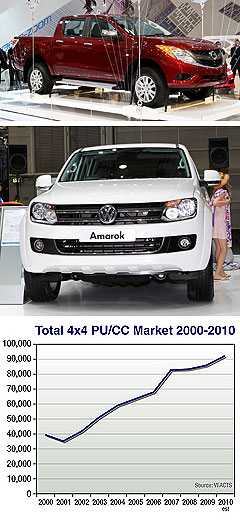The pick-up rises, from trades hall to high street
BY TERRY MARTIN | 19th Oct 2010

As the monumental and sustained rise in sales of SUVs and 4x4 utilities shows, Australians are, in massive numbers, preferring to spend their money on vehicles that better suit their lifestyles.
Yes, ‘lifestyle’. This is often the cue to roll out clichés about Australia’s wide open spaces, our spirit for adventure, and so on, which are invariably used to explain the popularity of 4WD wagons and, more recently, 4x4 dual-cab utes.
Based on personal and anecdotal experience, though, the phenomenal rise of the 4x4 pick-up has more to do with using the work vehicle for weekend family motoring, for towing a boat or caravan (et al), for taking rubbish to the tip, and for loading all manner of dirty, sandy, cumbersome recreational gear into the tray and heading to the bush or beach or wherever.
Never mind that pick-ups routinely tip the scales at two tonnes or more, and are heavy on fuel and other operating costs.

An increasingly large proportion of Australians want the versatility these vehicles offer and are being well catered for by manufacturers who are not only meeting their needs with aspects such as towing capacity and a sufficiently gutsy engine to do the job, but are also now building cabins that are roomy, comfortable and equipped with safety and convenience items akin to a passenger car.
Moreover, the big-name brands are also now ensuring their light trucks are relatively refined and quite manageable on the road, and are reaping the rewards – to the point where more than 90,000 4x4 utes are expected to be sold this year in what has become one of the biggest markets in the world for this type of vehicle.
That is one of the reasons why Ford Australia was given the job of developing the new-generation Ranger and why both Ford and Mazda chose last week’s Sydney motor show as the venue for the world debut of, respectively, the Ranger and its mechanical twin, the BT-50.
At the turn of last decade, 4x4 utes were largely the domain of tradies, with fewer than 40,000 of them sold each year. But as the vehicles have transformed, so too have sales, led by the Toyota HiLux (which entered its seventh generation in 2005), the redesigned Nissan Navara (D40 launching late in that same year) and the Mitsubishi Triton (ML arriving mid-2006).
Sales rocketed from 60,000 mid-decade to more than 80,000 in 2007 as Ford and Mazda also improved their outlook with the rebodied Ranger (replacing Courier) and BT-50 (replacing B-Series) respectively, and the segment as a whole has never looked back.
Looking closer at the figures, though, while HiLux has been the standout performer over the period, Ford has fared only reasonably well and Mazda has failed to take full advantage of the trend with a model it admits is more utilitarian than the market now expects.
Ranger’s share of the 4x4 ute segment has climbed modestly from 7.5 per cent in 2007 to 10.1 per cent YTD, while the BT-50, after a spike from 6.2 to 7.4 per cent from 2007 to 2008, has fallen to 5.0 per cent in 2010 YTD.
Both companies are now looking for substantial sales growth when their fully redesigned ‘lifestyle’ vehicles reach the market in the second half of next year, with Mazda in particular wanting to double its share of the light truck market (which includes 4x2 workhorse models) and seeking a significant spike in dual-cab sales, which the company says now outsell single-cabs two to one.
In YTD sales, the BT-50 is one of the few 4x4 utes in negative territory (-3.0 per cent) while the segment is up 18.8 per cent and pushing ahead with plenty of private sales – up 18.5 per cent for all LCVs YTD – after the federal government’s small business tax break last year kept business sales buoyant during 2009 and the first part of this year.
By comparison, the HiLux is up 17.8 per cent YTD, the Ranger 29.9 per cent and Navara 22.9 per cent, while Holden is continuing to find traction with Colorado (up 13.1 per cent) and Isuzu Ute is doing likewise, albeit on smaller volumes, with the mechanically similar D-Max (nee Rodeo) – up 97.4 per cent YTD. Triton is the only other big name in negative territory, down 0.7 per cent YTD.
Despite the government’s tax incentives, the BT-50 was down 9.8 per cent last year when its major rivals all experienced growth – the obvious exception being HiLux, which slipped 9.9 per cent but still owned 27 per cent of the segment.
The launch of the all-new Volkswagen Amarok next year looks set to further grow the 4x4 utility segment, bringing more private buyers and family types into the market, but it will also place pressure on the established nameplates.
In turn, the trend towards increasing specification on high-end 4x4 dual-cab utes with important features such as electronic stability control and curtain airbags should continue across a broader range of brands and also model variants.
Toyota, for one, has followed the lead taken by Mitsubishi and Nissan in upgrading flagship variants of its volume-selling one-tonner with more safety equipmentThe market leader will not let HiLux’s stranglehold of the 4x4 ute market – currently at 26.9 per cent YTD – erode at the hands of better-specified competitors, but it has a fight on its hands as VW, Ford, Mazda and, in a further 12 months, Holden, Isuzu and other brands, enter with what should be excellent redesigned models.
That then leaves Toyota as the next in line to raise the bar further with an all-new HiLux about 2012-13.
By that stage, the 4x4 ute market should be easily racking up more than 100,000 annual sales.